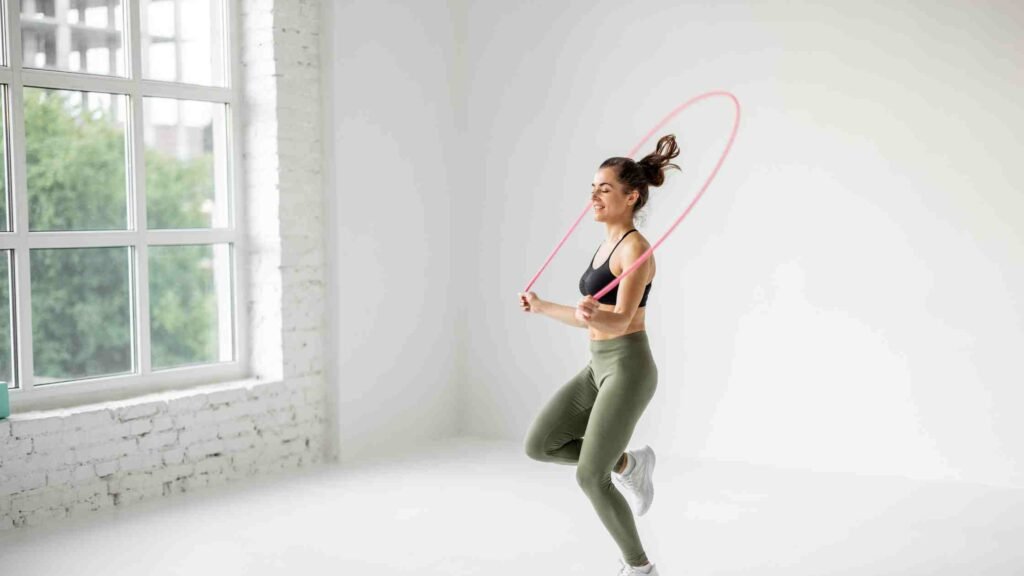There are many reasons why people obsess about jumping rope. And we are sure that knowing all the benefits of jumping rope will make you want to add it to your daily exercise routine.
Though jumping ropes sounds like an old-school workout tool for many, this inexpensive portable cardio is bliss for total body strengthening. Especially for people who don’t want to get out of their homes and still want to indulge in an intense and sweaty workout routine, nothing can make a more excellent choice than jumping rope exercising.

Beyond that, jumping rope exercising also provides various athletic benefits, from coordination to increase agility. It is another fun activity that people of all age groups might like.
Perhaps it’s no surprise that jumping rope exercising is rising in popularity as a form of weight loss activity. But there are many other benefits of jumping rope beyond weight loss. Gym trainers, fitness freaks, and even influencers over social media platforms have recently expressed their interest in jumping rope. They recommend this activity as a tool for people to stay active, especially those who want to avoid exercising at gyms.
Read more about How to Lose Belly Fat Naturally?
In this article, we will get deeper into the benefits of jumping rope beyond weight loss, and here is more that you should know about this stellar exercise form.
What Is A Jumping Rope?
A jumping rope is made of a rope with two ends, each with a wooden or plastic handle to have a grip while swinging it around the body and jumping over it as it passes under the feet.
Jumping rope exercising is more like cardiovascular training since constant movement increases the heart rate. The basic concept of jumping rope is very simple, yet depending upon an individual’s fitness goals, there are many ways to use the jump rope.
For example, some people prefer jumping at a fast pace when they train for agility and speed. On the other hand, others might focus on jumping up and swinging the rope under their feet twice before they land again to develop power.
Other people use a jump rope as a prop and try unique and dance-like movements.
However, how you choose to use a jump rope is, of course, totally up to you. But, a jump rope workout can be a great exercise on its own whether you use it as a warm-up or cool-down before or after your weight training and intense exercising.
How To Start With Jump Rope?
You don’t need any certification or pro-level skills to jump rope. All you need is to buy an appropriately sized rope, an appropriate location, comfortable clothing, and just a little knowledge about jumping.
But remember to have the most of a jumping rope exercise; you need to ensure that the rope is the right size. But how will you do that?
Grab the handles of the rope with both your hands and then step one foot into the middle of the rope. Pull the handles so that both handles are even with each other. Now, if the top of each handle reaches your armpits, your rope is the correct size. And once they don’t get your armpits, you need to search for a longer rope. However, if your rope is too long according to your height, you can adjust the length by tying a strong knot beneath the handles of each side.
Don’t practice jumping rope on a hard surface like a concrete floor because that can be hard on your knee joints. On the other hand, soft surfaces like sand and grass are not great for practicing jumping rope, too, as they need to provide more pushback. Always practice jumping rope on a mat if possible. You can use your yoga mat or buy a specialized mat for jumping rope.
Jumping rope on the top of a mat softens the impact on your knee joints. You can also prefer jumping on a wooden floor or gym floor.
As for your shoes, you can wear supportive sneakers, and for clothing, you can prefer anything you are comfortable with but remember it should not be too baggy since baggy clothes can get caught on the rope.
What Is The Best Posture For A Good Jump Rope?

Your jumping rope exercise must start with a good posture. You must keep your back straight, your eyes looking straight ahead, and your chest up to form an appropriate stance for practicing jumping rope. You must also position your elbows at about 2 inches from each side and at the midline of your body while ensuring that your hands are pointing straight out.
Now with the handles of the rope in your hands, you can turn the rope in small circles with your wrists. You can bend your knees softly while staying on the balls of your feet and jump high only when the rope comes low to the ground. You must not jump higher since just about an inch to clear the rope is enough.
You can jump for longer when you keep your jumps low to the ground. And also faster since you will not be spending excess energy.
Read more about What Are the Best Calorie-Burning Workouts, and How Many Calories Do They Burn?
What Are The Most Commendable Benefits Of Jumping Rope Beyond Weight Loss?
People who are trying to lose weight prefer jumping ropes. But the benefits of jumping rope are not only limited to weight loss. There are many other benefits that you should know about before adding jumping rope to your daily exercise routine.
Here Are Some Of The Most Mentionable Benefits Of Jumping Rope.
It’s An Efficient Form Of Cardio
Cycling, dancing, hiking, kickboxing, running-there are endless options for cardiovascular exercises that improve your overall quality of life. And when it comes to your overall health and healthy lifestyle, a single cardio exercise is not enough.
On the other hand, only some find it comfortable to indulge in any cardiovascular activities, especially if they are exhausting. And for those looking for an effective cardio option without hitting the gym, jumping rope is the best exercise to help.
Jumping rope can speed up the heart rate since it involves many muscle groups exercising simultaneously.
According to the Centers For Disease Control And Prevention, jumping rope is a vigorous-intensity activity. Practicing one minute of jumping rope is similar to moderate-intensity exercise like brisk walking or playing double tennis for two minutes. And therefore, there is no denying that jumping rope brings many health benefits, such as reducing the risk of heart disease and diabetes.
Incorporating jumping rope into your daily exercising routine, you can get the same benefits of any moderate-intensity activity in about half the time.
It Strengthens Your Entire Body
Jumping rope is more like a full-body exercise. Since it engages from head to toe simultaneously, there is nothing better than jumping rope for people looking to exercise the whole body at once.
The movement of jumping rope mainly focuses on the legs and the muscles of the ankles and feet. It also works for the biceps, shoulders, and core. The best part of jumping rope exercising is that you don’t need to pay special attention to any particular muscle group since it engages all the muscles simultaneously while you jump. Therefore, it tends to happen naturally.
Boosts Bone Density
Our bone density reduces when we age. And therefore, people, after they are 30, looking for full-body exercising that also focuses on boosting bone density must include jumping rope in their daily routine since it includes jumping; our bone density increases in jumping rope exercise.
In a study then in 2015, it was found that pre-menopausal women could improve their hip bone mineral density with a jump rope—low bone density results in various health conditions, including osteomalacia and osteoporosis. And therefore, after 30, women are more prone to fractures. By practicing jumping rope, one can reduce the risk of those issues.
Furthermore, people with health conditions like osteoporosis can also start jumping rope. But it is always best to ask our doctor since the high impact of exercising can be harmful to already weakened bones.
Read more about Ketogenic Diet for Weight Loss
Increases Agility
If you practice jump rope correctly, it will include moving from the balls of your feet. And that way, it develops agility by bringing you the chance for good footwork. People involved in sports requiring quick direction change, such as volleyball, basketball, and boxing, must practice jump rope to increase agility.
Improves Coordination
It takes much coordination between your hands, feet, and eyes while practicing jump rope. And therefore incorporating jump rope into your daily exercising routine help you increase coordination with time.
When you practice jump rope, you must ensure that the rope swing is proper and that you jump over at the right time. And since the pattern goes in repetition, it requires a high level of coordination that might feel super challenging at first, but when you stick to it, you will see your baseline skills improve.
Once this happens, you can tackle new footwork patterns and treat them with the jump rope, making your exercise fresher and more fun.
Enhances Balance
If you are looking for an efficient way to boost your balance, jumping rope is the best practice you can try. In a small study in 2015 among young soccer players, it was concluded that jumping rope as a part of their regular soccer program is an additional method to improve balance. The study explained that when you jump rope, you must reestablish your balance between each jump and an excellent balance to jump again effectively.
Many other studies find that lower muscular power correlates to better agility and balance. You can also practice other jump rope drills, such as jumping on just the ball of one foot or jumping side by side to challenge your balance further.
Increases Explosive Power
Once you are assured about the basic jump rope technique, you can learn other moves like that double under. Double under will require a more forceful and higher jump which means that you can increase your explosive power. Improving explosive power means doing well in other sports, like volleyball, where perpendicular jumps are involved.
Benefits Of Jump Rope For Your Mental Health

It’s Meditative
Though jumping rope is more like an intense activity, it can be very meditative too. Most people practice jumping rope in a rhythm. And when they get into their groove, you can get lost in that.
Jumping rope is an active meditation that lets the person focus on keeping a steady rhythm and nothing else. One can play a mindfulness game with jump rope too by closing their eyes and taking a few seconds to listen to the sound of the rope and other sounds and sensations in the surrounding environment.
Improves Awareness
Improved spatial awareness is one of the mentionable results of practicing jumping rope regularly. It happens because when you constantly be aware of what is in front and behind alongside the sides while jumping rope, especially in a small space, you become excessively mindful so that you don’t hit any nearby objects with the rope.
The level of improvement you will notice in your spatial awareness through jumping rope activity can make you a better athlete. Also, in your life, there will be many scenarios where you need to be aware of the place and be agile.
Read more about Things to Avoid to Lose Weight
It’s Fun
Jumping rope is full-body coordination that can be challenging at first. But when you consistently practice jump rope, you improve your skills quickly, and when you do that, it will be much fun. Perhaps you will be happy to find out a new trick to try, or you can also fall in love with the meditative qualities of jump rope.
How To Avoid Injuries While Jumping Rope
Jumping rope is indeed an effortless exercise. But in many cases, it might cause injury if not done right. And therefore, all you have to do is know the right ways of jumping rope and understand some precautionary actions that you can take to keep yourself safe against any possible self-damage.
First of all, remember to hop up and down using the rope, but understand that all the muscles of our body are involved in this exercise; therefore, any single wrong jump can prove dangerous for you.
Most athletes use a jump rope to improve their eye coordination and muscle endurance, and it also helps people get in shape, strengthen their leg muscles, and even lose weight. But before that, know what you need to care about while skipping a rope.
Don’t Choose A Wrong Rope
We already discussed how to choose the correct rope for yourself. It is essential because selecting the suitable rope only can help you get the most out of it. And if the adverse happens, you might harm yourself physically. When folded, your rope must reach your shoulders so that you can get enough space to jump comfortably. Also, remember that the handles of the rope should be light enough.
Choose The Right Surface
Always choose a flat surface while jumping, or you can hurt your knees and ankles. Jumping on an even surface, indoor or outdoor, must be preferable to get some extra bounce, and your knees don’t need to take any additional strain. Always avoid concrete floors to help your row bounce and avoid high jumps.
Handle The Rope Correctly
While handling the rope, not only your palms but your fingers, too, are involved. Always hold the grip tightly to keep your rope firm. A firm grip on the rope will allow you to turn it better. Before starting the jumps, you must stretch your hands and forearms at least a foot away from your body and at a 45-degree angle.
Engage Your Wrists
While swinging the rope, you must use your wrist more and not your arms. Always ensure that your hands are near the front of your hip bones, and your wrist is the major part of the work. If you use your arms, your movement will be slowed down naturally.
Never Jump With A Hunched Back
While jumping a rope, your back should be straight and neutral. Remember, it’s your butt and your hamstring that need to take the maximum impact, not your body. Jumping with a hunched back may lead to back aches and other problems, and you will not also get the maximum benefit from this exercise. Also, keep your chest and head up while your shoulders must be pulled back.
Don’t Jump Too High
You don’t need to jump too high from the ground while practicing jumping rope. Your jump height must not exceed 1/2 to 1 inch from the ground. When you jump higher, it will reduce your speed and decrease the impact. Also, keep your legs together while jumping and bending your knees slightly.
Don’t Bounce Twice
Many people make a common mistake while practicing jumping rope-they jump twice between each spin. If you are a beginner, try not to do this. And if you have already made that habit, it is time to break that by practicing. Try to swing the rope faster so that you bounce only once.
Some Frequently Asked Questions About Jumping Rope
What Is Jump Rope Good For?
Jump rope is an inexpensive, quick, and effective workout that can increase your cardiorespiratory fitness while building strong bones and muscles. You also can improve your body’s balance and coordination by practicing jump rope daily. In many cases, jumping rope is used as an exercise practice for losing weight. Still, jumping ropes have many other benefits, such as increased agility and bone density.
Are 30 Minutes Of Jump Rope Enough?
Jumping rope for 30 minutes is considered a high-intensity workout that can burn between 300 and 450 calories depending on your weight throughout the day. Initially, if you are a beginner at jumping rope, you can start with 15 minutes of the activity and gradually increase the time depending on your endurance.
Will Jump Rope Reduce Belly Fat?
Skipping helps strengthen the core of the body, and hence it can help in reducing belly fat and tightening the abdominals. 10 minutes of skipping every day can burn up to 200 calories which is more effective than brisk walking. And when you continuously practice jumping rope for a long time, it helps improve your stamina and help you get rid of fatigue.
Is It OK To Jump Rope Every Day?
No matter what your existing exercise routine is, you can include a jump rope in it. Three to five times a week is enough if you are starting with the jump rope. However, remember that if you are increasing your daily jump rope timing, you must keep your workouts relatively short and your intensity low to avoid exhausting your body.
Is Jumping Rope Better Than Walking?
If you choose jump rope over walking, it is guaranteed that you will burn more calories. For example, if you are jumping rope for 5 minutes and walking on a treadmill for 5 minutes, you will be able to burn more in jumping rope simultaneously. When you jump rope, your upper body, lower body, and core involve altogether, and it helps you get overall fitness for your body.
Is Jump Rope OK For Knees?
If you don’t have any severe bone conditions such as arthritis, or osteoporosis, jump rope is not bad for your knees. However, if you have any of the conditions mentioned above, you must talk to your doctor before trying jump row.
Conclusion
There is no doubt that jumping rope has many benefits beyond weight loss. And there is no investment included in this exercise since it requires only the suitable rope, and you are all set to start at your home. Jumping rope burns many calories, strengthens your coordination and bone density, and reduces the risk of injuries and heart diseases. Therefore, jumping rope will be perfect for you if you are looking for a fun way to mix up your workout and add some playfulness to your routine. You can also jump along to some music and practice the same activity in a nearby park to increase the fun.
